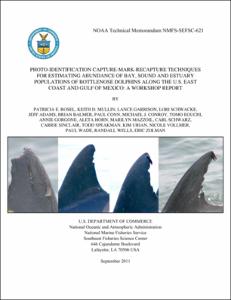| dc.contributor.author | Rosel, Patricia | |
| dc.contributor.author | Mullin, Keith | |
| dc.contributor.author | Garrison, Lance | |
| dc.contributor.author | Schwacke, Lori | |
| dc.contributor.author | Adams, Jeff | |
| dc.contributor.author | Balmer, Brian | |
| dc.contributor.author | Conn, Paul | |
| dc.contributor.author | Conroy, Michael | |
| dc.contributor.author | Eguchi, Tomo | |
| dc.contributor.author | Gorgone, Annie | |
| dc.contributor.author | Hohn, Aleta | |
| dc.contributor.author | Mazzoil, Marilyn | |
| dc.contributor.author | Schwarz, Carl | |
| dc.contributor.author | Sinclair, Carrie | |
| dc.contributor.author | Speakman, Todd | |
| dc.contributor.author | Urian, Kim | |
| dc.contributor.author | Vollmer, Nicole | |
| dc.contributor.author | Wade, Paul | |
| dc.contributor.author | Wells, Randall | |
| dc.contributor.author | Zolman, Eric | |
| dc.date.accessioned | 2021-12-16T17:16:21Z | |
| dc.date.available | 2021-12-16T17:16:21Z | |
| dc.date.issued | 2011 | |
| dc.identifier.citation | Rosel, P., Mullin, K., Garrison, L., Schwacke, L., Adams, J., Balmer, B., Conn, P., Conroy, M., Eguchi, T., Gorgone, A., Hohn, A., Mazzoil, M., Schwartz, C., Sinclair, C., Speakman, T., Urian, K., Vollmer, N., Wade, P., Wells, R. and Zolman, E. (2011) Photo-identification capture-mark-recapture techniques for estimating abundance of bay, sound and estuary populations of bottlenose dolphins along the U.S. East Coast and Gulf of Mexico: A workshop report. Miami, FL, NOAA, National Marine Fisheries Service
Southeast Fisheries Science Center, 38pp. (NOAA Technical Memorandum NMFS-SEFSC-621). DOI: http://dx.doi.org/10.25607/OBP-1687 | en_US |
| dc.identifier.uri | https://repository.oceanbestpractices.org/handle/11329/1819 | |
| dc.identifier.uri | http://dx.doi.org/10.25607/OBP-1687 | |
| dc.description.abstract | Bay, sound and estuary (BSE) populations of bottlenose dolphins are common along the U.S. Atlantic and Gulf of Mexico coasts. NOAA Fisheries currently identifies 9 BSE stocks in the Atlantic and 32 in the northern Gulf of Mexico. Accurate abundance estimates for these stocks are an essential component of MMPA-mandated stock assessment, yet only three of these BSE stocks have up-to-date abundance estimates. Abundance estimates based on data more than 8 years old are not considered valid for management (i.e., to estimate PBR) under the MMPA and those more than 5 years old drop a stock assessment from adequate to inadequate under the NOAA Fisheries Stock Assessment Improvement Plan. For most stocks in U.S. waters, aerial
and/or large vessel line-transect surveys provide the platforms for abundance estimation. Linetransect “distance” analysis methods from vessels and planes are relatively well understood and these methods are more or less standardized. While line-transect surveys using small boats may be appropriate for some estuarine systems, such surveys are not suitable when working inside estuarine waters with complex topography and turbid waters. As a result, alternative methodologies have been utilized, most centered around the use of photo-identification (photo- ID) capture-mark-recapture (CMR) techniques. However, CMR studies using photo-ID are more complex in terms of design constraints and analytical methods and do not have a well-defined “standard” approach for populations of cetaceans residing in topographically complex estuarine habitats. Furthermore, the areas
inhabited by most BSE stocks often experience influxes of non-resident animals, further complicating the ability to obtain an abundance estimate for the resident stock alone. In many cases, field methods for collecting photo-ID data, definitions of residency and analytical tools are not standardized across studies of different BSE stocks. These differences in methodologies
affect resulting abundance estimates and make comparison of abundance estimates and PBR calculations across different BSE stocks difficult. The Workshop sought to develop agreed upon best practices for fieldwork, photo processing and analytical practices for estimating abundance for estuarine bottlenose dolphin populations in the Southeast United States using CMR methods. | en_US |
| dc.language.iso | en | en_US |
| dc.publisher | NOAA Southeast Fisheries Science Center | en_US |
| dc.relation.ispartofseries | NOAA Technical Memorandum;NMFS-SEFSC-621 | |
| dc.rights | CC0 1.0 Universal | * |
| dc.rights.uri | http://creativecommons.org/publicdomain/zero/1.0/ | * |
| dc.subject.other | BioICE | en_US |
| dc.subject.other | Photo-identification | |
| dc.subject.other | IOOS Marine Life | |
| dc.title | Photo-identification Capture-Mark-Recapture Techniques for Estimating Abundance of Bay, Sound and Estuary Populations of Bottlenose Dolphins along the U.S. East Coast and Gulf of Mexico: a Workshop Report. | en_US |
| dc.type | Report | en_US |
| dc.description.status | Published | en_US |
| dc.format.pages | 38pp | en_US |
| dc.description.refereed | Refereed | en_US |
| dc.publisher.place | Miami, FL | en_US |
| dc.subject.parameterDiscipline | Birds, mammals and reptiles | en_US |
| dc.description.currentstatus | Current | en_US |
| dc.description.sdg | 14.a | en_US |
| dc.description.eov | Marine turtles, birds, mammals abundance and distribution | en_US |
| dc.description.adoption | Validated (tested by third parties) | en_US |
| dc.description.adoption | Organisational | en_US |
| dc.description.ebv | Species abundances | en_US |
| dc.description.ebv | Species distributions | en_US |
| dc.description.methodologyType | Method | en_US |
| obps.contact.contactemail | patricia.rosel@noaa.gov | |
| obps.resourceurl.publisher | www.sefsc.noaa.gov | |
 Repository of community practices in Ocean Research, Applications and Data/Information Management
Repository of community practices in Ocean Research, Applications and Data/Information Management

